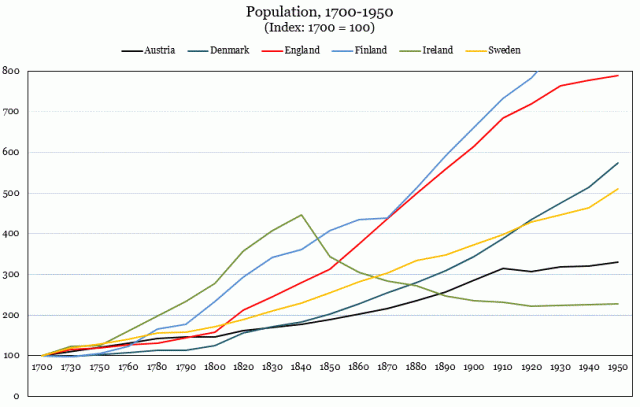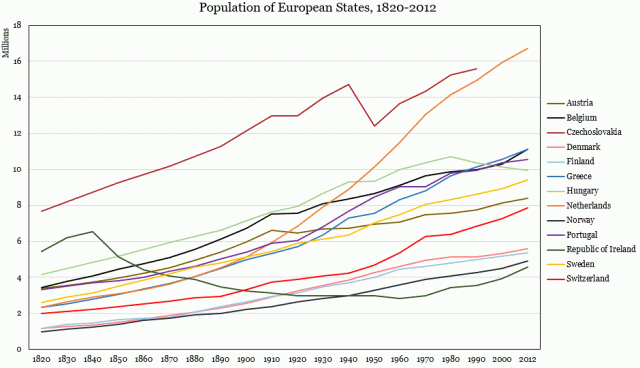Ireland’s population history makes it an outlier in Europe. What is now the Republic of Ireland is the only state in the developed world that has a population lower than its mid-nineteenth century level [1]. It would not be until the 1960s that the Republic saw a sustained increase in its population, ending more than a century of population decline. Though a watershed, the Famine only caused less than half of the depopulation before independence. The decline was in the long-run. Post-famine Ireland developed a unique combination of very high emigration, large families, but a high celibacy rate. The last variable meant that even without emigration Ireland’s population would have grown less than the European average at the turn of the century [2].
Of course this is all partitionist. In what is now Northern Ireland population started to rise again in the 1890s and for the island as a whole in the 1930s. The North’s population reached its pre-Famine level in the 2001 census. A fact that indicates southern Ireland’s demographic woes were in large part due to a lack of economic development and urbanization.
The island’s peak population of 8.5 million on the eve of the Famine draws some striking comparisons. Ireland’s population in the 1840s was probably larger than Brazil, Mexico, the Philippines, the Benelux countries and all of Scandinavia [3]. In 1845 Ireland constituted a third of the United Kingdom; if the full Union still existed Ireland would be a tenth of it. Back then it comprised 5% of Western Europe; today it’s about 1.5%. 0.007% of the world’s population resided in Ireland before the Great Famine; today it’s a mere 0.0009%! Some of this is perhaps spurious, but as the graphs illustrate below Ireland’s population history is at odds with its European peers.
 An obvious correlation made by nationalists was that this was the fault of British rule. Unfortunately decline continued well into independence, with emigration still a factor at present. From 1920 to the 1990s only Ireland and East Germany saw declines in population for extended periods [3]. Both were the only countries in Europe to see drops in the 1950s, a decade where much of Europe enjoyed a post-war boom. When the East German government built the Berlin Wall to stop the flow of refugees in 1961, The Belfast Telegraph reminded its readers that proportionately more leave Ireland each year [4]. Indeed census year would usually be a fine source of propaganda for the Unionist politicians and press. And in truth, it was not an invalid source.
An obvious correlation made by nationalists was that this was the fault of British rule. Unfortunately decline continued well into independence, with emigration still a factor at present. From 1920 to the 1990s only Ireland and East Germany saw declines in population for extended periods [3]. Both were the only countries in Europe to see drops in the 1950s, a decade where much of Europe enjoyed a post-war boom. When the East German government built the Berlin Wall to stop the flow of refugees in 1961, The Belfast Telegraph reminded its readers that proportionately more leave Ireland each year [4]. Indeed census year would usually be a fine source of propaganda for the Unionist politicians and press. And in truth, it was not an invalid source.
Though Ireland may be unusual among today’s countries, it isn’t really the case among regions. The 19th century saw a mass transfer of people from the countryside into the cities. Thus there are undoubtedly many areas or regions throughout the developed world that have experienced severe depopulation. The Dust Bowl in North America being the most famous. One example very relevant to Ireland is the Scottish Highlands and Islands, whose population is also lower than its mid-19th century level (see graph below). Modern falls in population are now the reality for developed states because of falling birth rates. Several former communist states have had decreases for many decades now. Saxony in the former East Germany has seen its population fall since the 1950s. Ireland appears to be losing its exceptionalism as time moves on.

“Scottish Economic Report December 2005”: http://www.gov.scot/Publications/2005/12/01160340/03443
NOTE – The online sources for the graphs are:
- Angus Maddison’s dataset: “Statistics on World Population, GDP and Per Capita GDP, 1-2008 AD”, http://www.ggdc.net/maddison/oriindex.htm
- Jan Lahmeyer’s website on population stats: http://www.populstat.info
B. R. Mitchell’s books are often the source for population statistics. But you either need access to a good library or have money to burn. See also Maddison’s OECD reports and the Atlas on World Population History.
[1] Mary Daly, “The Slow Failure: Population Decline and Independent Ireland, 1920-1973” (2006), page 3. The island of Ireland’s overall population is also lower.
This claim is often made, and appears to be true for OECD countries’ by their current borders. Because of border changes, some countries have a higher population in the statistics. For example, as part of the Russian Empire, Lithuania in the mid-19th century had a higher population than now. But only because it included much of Belarus, including Minsk.
[2] Timothy Guinnane, “The Vannishing Irish” (1997), page 7.
[3] In 1850 the estimated population of Brazil is 7.3 million, Mexico 7.6 million and the Philippines 3.6 million. Benelux’s 1845 total is approximately 7.3 million: Belgium, 4.259 million; Netherlands, 3.014 million; Luxembourg 186,000. Scandinavia in 1845 about 6.3 million: Denmark: 1.43 million; Finland: 1.536 million ; Iceland: 58,600 ; Sweden: 3.317 million. All figures are from Maddison dataset, except Iceland and Luxembourg which are Lahmeyer’s.
[4] Cormac O Grada, “The Rocky Road: The Irish Economy Since the 1920s” (1999), page 192.
[5] Daly, page 183.


